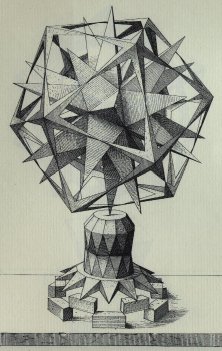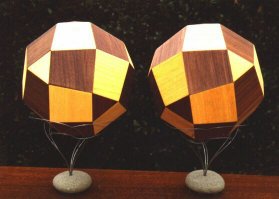The chief reason for studying regular polyhedra
is still the same as in the time of the Pythagoreans,
namely, that their symmetrical shapes appeal to
one's artistic sense.
---H.S.M. Coxeter
 Through
history, polyhedra have been closely associated with the world of art.
The peak of this relationship was certainly in the Renaissance. For some
Renaissance artists, polyhedra simply provided challenging models to demonstrate
their mastery of perspective. For others, polyhedra were symbolic
of deep religious or philosophical truths. For example, Plato's association
in the Timaeus between the Platonic solids and the elements of fire,
earth, air, and water (and the universe) was of great import in the Renaissance.
This was tied to the mastery of geometry necessary for perspective, and
suggested a mathematical foundation for rationalizing artistry and understanding
sight, just as renaissance science explored mathematical and visual foundations
for understanding the physical world, astronomy, and anatomy. For
other artists, polyhedra simply provide inspiration and a storehouse of
forms with various symmetries from which to draw on. This is especially
so in twentieth century sculpture, free of the material and representational
constraints of earlier conceptions of sculpture.
Through
history, polyhedra have been closely associated with the world of art.
The peak of this relationship was certainly in the Renaissance. For some
Renaissance artists, polyhedra simply provided challenging models to demonstrate
their mastery of perspective. For others, polyhedra were symbolic
of deep religious or philosophical truths. For example, Plato's association
in the Timaeus between the Platonic solids and the elements of fire,
earth, air, and water (and the universe) was of great import in the Renaissance.
This was tied to the mastery of geometry necessary for perspective, and
suggested a mathematical foundation for rationalizing artistry and understanding
sight, just as renaissance science explored mathematical and visual foundations
for understanding the physical world, astronomy, and anatomy. For
other artists, polyhedra simply provide inspiration and a storehouse of
forms with various symmetries from which to draw on. This is especially
so in twentieth century sculpture, free of the material and representational
constraints of earlier conceptions of sculpture.
This page is an index into various other pages which touch upon the connections between polyhedra and art in one form or another. Note that I am not trained in the history of art, so my thoughts in these areas do not necessarily reflect the accepted opinions.
 There
are many sculptors of the 20th century who should be added to the above
list. Examples would include Helaman Ferguson, Charles Perry, John
Robinson, and Kenneth Snelson. However, I have not yet made the effort
to collect permission to reproduce images of their works.
There
are many sculptors of the 20th century who should be added to the above
list. Examples would include Helaman Ferguson, Charles Perry, John
Robinson, and Kenneth Snelson. However, I have not yet made the effort
to collect permission to reproduce images of their works.